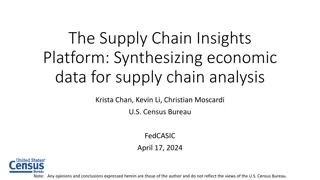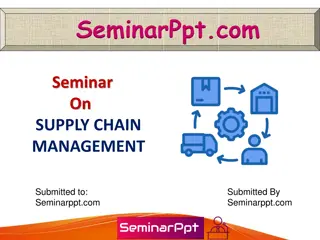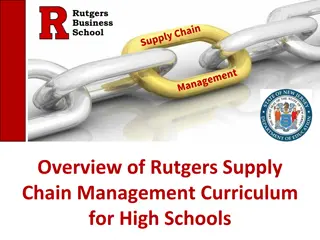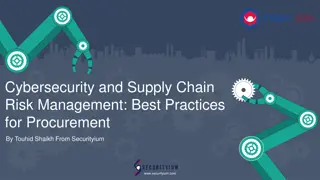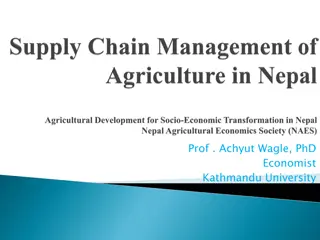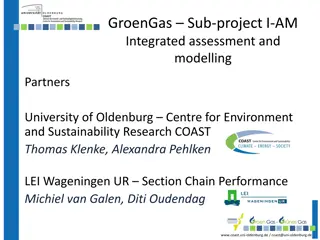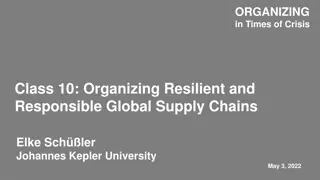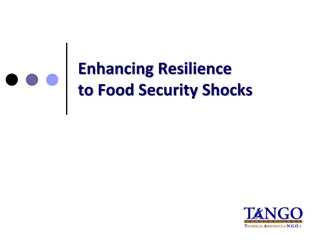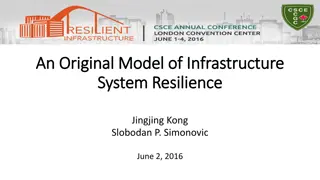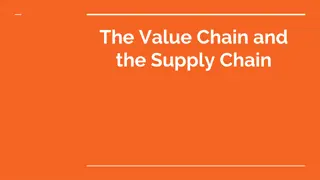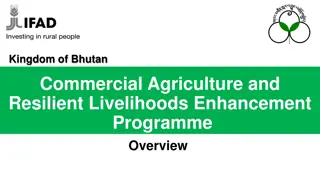Resilient Food Systems Infrastructure Program for Building Supply Chain Resilience
The Resilient Food Systems Infrastructure Program aims to enhance the middle stages of the food supply chain in South Carolina by supporting processing, aggregation, and distribution of agricultural products. Funding opportunities are available for agricultural producers, processors, nonprofit organizations, local government entities, tribal governments, and institutions to improve infrastructure, equipment, and compliance with food safety regulations. The program focuses on expanding capacity, modernizing systems, enhancing worker safety, and promoting market development.
Download Presentation

Please find below an Image/Link to download the presentation.
The content on the website is provided AS IS for your information and personal use only. It may not be sold, licensed, or shared on other websites without obtaining consent from the author. Download presentation by click this link. If you encounter any issues during the download, it is possible that the publisher has removed the file from their server.
E N D
Presentation Transcript
Resilient Food Systems Infrastructure Program rfsi@scda.sc.gov
Purpose Develop and administer state coordinated initiatives to build resilience across the middle of the State s food supply chain for food crops. Funds will support expanded capacity for the aggregation, processing, manufacturing, storing, transporting, wholesaling, and distribution of locally and regionally produced food products, including specialty crops, dairy, grains for consumption, aquaculture, and other food products, excluding meat, poultry, and wild caught seafood. South Carolina has been awarded $4,983,549 to administer the program and make competitive subawards for infrastructure and equipment
Middle-of-the-supply-chain The food supply chain involves the following stages: 1. Production, 2. Processing, 3. Aggregation/Distribution, and 4. Markets/Consumers. For the purposes of RFSI, middle-of-the-supply-chain refers to the middle stages: 2. Processing and 3. Aggregation/Distribution Grants cannot be used for production activities ex. purchase of a tractor
Who can apply for funding? Agricultural producers or processors, or groups of agricultural producers and processors Nonprofit organizations operating middle-of-the-supply-chain activities such as processing, aggregation, distribution of targeted agricultural products Local government entities operating middle-of-the-supply-chain activities such as processing, aggregation, distribution of targeted agricultural products Tribal governments operating middle-of-the-supply-chain activities such as processing, aggregation, distribution of targeted agricultural products. Institutions such as schools, universities, or hospitals bringing producers together to establish cooperative or shared infrastructure or invest in equipment that will benefit multiple producers middle-of-the-supply-chain activities such as processing, aggregation, distribution of targeted agricultural product.
What can I use the funding for? Expand capacity for processing, aggregation and distribution of agricultural products to create more and better markets for producers; Modernize manufacturing, tracking, storage, and information technology systems; Enhance worker safety through adoption of new technologies or investment in equipment or facility improvements; Improve the capacity of entities to comply with federal, state, and local food safety requirements; Improve operations through training opportunities;
What can I use the funding for? Support construction of a new facility; Modernize or expand an existing facility (including expansion and modifications to existing buildings and/ or construction of new buildings at existing facilities); Construction of wastewater management structures, etc.; Modernize processing and manufacturing equipment; and Develop, customize, or install equipment that reduces greenhouse gas emissions, increases efficiency in water use, improves air and/or water quality, and/or meets one or more of USDA s climate action goals.
Infrastructure Grants $100,000 minimum award and $3,000,000 maximum award Will fund projects to expand capacity and infrastructure for the aggregation, processing, manufacturing, storing, transporting, wholesaling, or distribution of targeted agricultural products 50% match requirement unless you self-identify as any of the following who qualify for a 25% match: Beginning farmer or rancher Veteran farmer or rancher Limited resource farmer or rancher Socially disadvantaged farmer of rancher Small disadvantaged business Women-owned small business Historically underserved farmer or rancher Using a USDA provided template, applicants are required to submit a project narrative that describes the overall scope of the project and how it aligns with the program goals and priorities. The narrative must include an estimated increase in production and who will benefit from the overall project (ag producers not consumers).
Examples of Infrastructure Grant Projects Expand capacity for processing, aggregation and distribution of agricultural products to create more and better markets for producers; Modernize manufacturing, tracking, storage, and information technology systems; Enhance worker safety through adoption of new technologies or investment in equipment or facility improvements; Improve the capacity of entities to comply with federal, state, and local food safety requirements; Improve operations through training opportunities;
Examples of Infrastructure Grant Projects Support construction of a new facility; Modernize or expand an existing facility (including expansion and modifications to existing buildings and/or construction of new buildings at existing facilities); Construction of wastewater management structures, etc.; Modernize processing and manufacturing equipment; and Develop, customize, or install equipment that reduces greenhouse gas emissions, increases efficiency in water use, improves air and/or water quality, and/or meets one or more of USDA s climate action goals.
Simplified Equipment-Only Grants These projects offer a simplified application to fund smaller grants between $10,000 and $100,000 for equipment purchases. The Simplified Equipment-Only option is a Fixed Price Grant, meaning it will fund only equipment purchases (and not associated facility upgrades, staffing, or other costs). No match is required for this grant type. Using a USDA provided template, applicants are required to submit a project narrative that describes the overall scope of the project and how it aligns with the program goals and priorities. Applicants must attach documentation to substantiate the costs of each piece of equipment, which can include contracts, catalog pricing, or binding quotes provided by license commercial entities.
Examples of Simplified Equipment-Only Grant Projects Must be within the USDA s definition of special purpose equipment for processing, aggregation, and distribution, such as: Canners Hulling processors Reverse osmosis systems Egg packing machines Flotation Tanks Other processing equipment, packing and labeling equipment, or delivery vehicles







